TABLE OF CONTENTS
- Introduction
- DLC
- Overview
- Dynasty Banners
- House Banners
- Fixed Historic Artifacts
- Random Religious Artifacts
- Random Non-Unique Artifacts
- Easter Egg Characters
- Analysis
This article was written under Crusader Kings 3 Game Version: Peacock (1.11.4)
Please note that much of the information in this article is based on anecdotal evidence and a lot of trial and error. I have not had the opportunity to delve into the actual source code, but I am happy to make any corrections if more accurate information is discovered. If you have any comments, you can either post here or e-mail me at: [email protected]
1. INTRODUCTION

This article explains how the starting artifacts in the 1066 start are allocated. Knowing how the system works can give you a major head start on your artifact collecting.
Crusader Kings 3 includes various mundane and legendary artifacts that can be worn by your character in their inventory (crown, weapon, armor, regalia, and 4 trinkets) and court artifacts that can be displayed in the royal court of a character of King or Emperor rank (throne, 3 large wall ornaments, 3 small wall ornaments, 2 furniture, 2 books, and 4 pedestal items). This adds an RPG dimension to CK3 as you try to equip your character (and dynasty) with the best inventory equipment and court artifacts.
Back in CK2, artifacts were initially represented as modifiers (like the Iron Crown of Lombardy or the +2 Axe) but the system was fleshed out later with the Monks and Mystics DLC. The CK3 mechanic also reminds me of the Great Works system that started in Civilization IV and the artifact collecting that started in Civilization V.
While the Crusader Kings 3 Wiki has a detailed section on artifacts https://ck3.paradoxwikis.com/Artifacts, the information can be confusing because it does not separate out the information for the 867 start date from the 1066 start date. Furthermore, it doesn't really explain the generation of random artifacts.
So this article is going to provide detailed information about the starting artifacts in 1066. You can find information about the starting artifacts in 867 in my previous article:
https://peakd.com/ck3/@byzantinekitty/ck3-starting-artifacts-in-867
Later on, I will write up a summary that compares the two start dates. (While in CK2 you could choose any start date, in CK3 you currently can only choose between 867 and 1066, which does make writing articles and guides a bit easier since you only have to cover two scenarios.) That article can be found here:
https://peakd.com/ck3/@byzantinekitty/ck3-867-vs-1066-starting-artifacts
2. DLC
For CK3, the Royal Court DLC added the royal court feature where you can display court artifacts and also introduced inspired people who you can sponsor to create artifacts for you.
The Fate of Iberia DLC added a few new artifacts (Bells of Santiago, Visigothic Votive Crown, Chalice of Dona Urraca).
The Tours and Tournaments DLC significantly reworked how artifacts could be obtained. Hunts now regularly generate mundane artifacts, prizes can be won in grand tournaments, and books can be obtained from university visits.
The Legacy of Persia DLC added some new artifacts (Sassanian Sword, Achaemenid Drinking Vessel, Oxus Bracelet, Incense Burner Sculpture). Several of these artifacts are present in the 867 start due to the Iranian Intermezzo. However, with the 1066 start, these artifacts can only be obtained during random travel events in the Persia region:

- One event is when you run across tomb raiders and have three different options to choose from. You can gain piety and a modifier that increases control growth and Courtly and Zealot vassal opinion but at the cost of decreased popular opinion. Another option is to lose gold to gain piety and a modifier to increase popular opinion. Or you can spend piety to attempt a Stewardship challenge which can give you a random artifact or an Ancient Treasures character modifier (which increases your prestige and gives a bonus to Courtly vassal opinion).
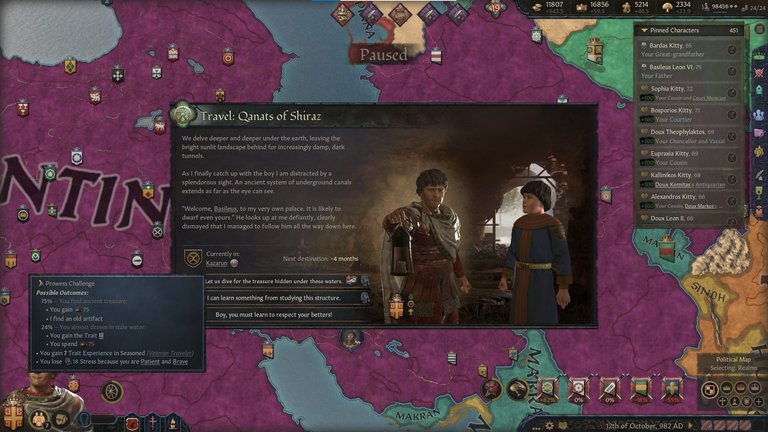
- A second event is when you encounter a child who vanishes into some caves. If you pass a Prowess challenge you can follow the child. You then have the option of gaining prestige, studying the qanats by passing a Learning challenge to gain prestige and a bonus to development growth, or passing a Prowess challenge to gain prestige and a random artifact.
In both of these events (which only seem to trigger once each for a given character), you can get artifacts such as a Sassanian Sword (I've seen Masterwork, Famed, and Illustrious versions. Common might be possible too), Achaemenid Drinking Vessels as an inventory trinket (which come in Common, Masterwork, Famed, and Illustrious versions and can be turned into pedestal court artifacts), Illustrious Oxus Bracelets (with varying effects), or Muslim or Zoroastrian religious artifacts (such as a Sword of Muhammad or Branch of the Sacred Cypress of Kashmar). Thus far, I have not seen an Incense Burner Sculpture obtained through these events.
- Thirdly, there is an event where you encounter Zoroastrians trying to save the dying embers of their sacred fire. If you offer them shelter, you have the chance to steal the embers, which gives you an Afarganyu artifact (there is a pedestal version and a trinket version) - however only Zoroastrian characters get the full benefit of the artifact.
3. OVERVIEW
I have grouped the artifacts into categories that I think make sense:
- Dynasty Banners
- House Banners
- Fixed Historic Artifacts
- Random Religious Artifacts
- Random Non-Unique Artifacts
- Easter Egg Characters
At the start of the game, every ruler with a royal court gets a House Banner and, if they are Dynasty Head, a Dynasty Banner as well.
There are 8 inventory artifacts and 23 royal court artifacts that are always allocated to specific historic characters in 1066.
6 Christian, 6 Muslim, 6 Buddhist, and 2 Hindu religious artifacts are randomly generated and given to King or Emperor characters of the appropriate religion (theocracies are not eligible).
2 Asatru, 1 Slavic, and 1 Senegambian religious artifacts are randomly generated and given to Count or Duke characters of the appropriate religion (mercenary leaders are eligible).
5 Visigothic Votive Crowns are given to random Iberian rulers that are of Count rank or higher. And 6 Excaliburs are given to random Counts or Dukes in Britannia or Francia.
Finally, there are 6 unlanded characters (presumably representing Paradox Interactive employees) who start with unique artifacts (but most are Common with just average abilities).
4. DYNASTY BANNERS
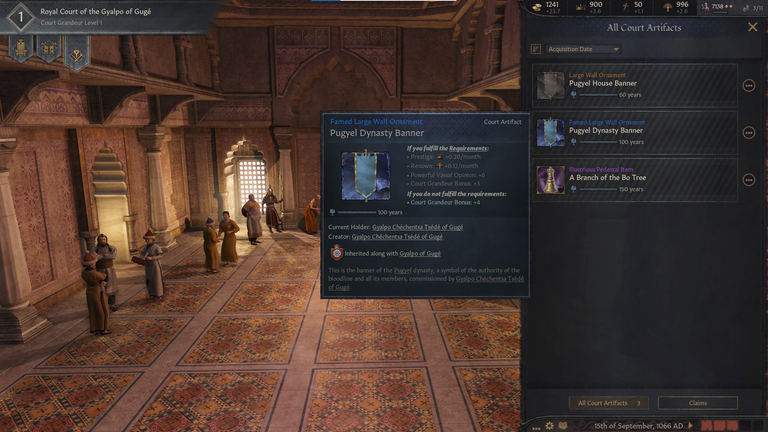
Every ruler with a royal court (i.e. King or Emperor level and who is not a Theocracy) who is their Dynasty Head starts with a Dynasty Banner. The quality of the Dynasty Banner seems to be related to the Level of Splendor of that dynasty. Most Dynasty Banners will be Common or Masterwork but in the 1066 start there is one character (Gyalpo Chechentsa Tsede of Guge) who starts with a Famed quality Dynasty Banner (for the Famous Pugyel dynasty).
As your dynasty accumulates Renown and improves its Level of Splendor, the Dynasty Banner (but not any House Banners) will periodically upgrade in quality level. However, when this happens, the effects at the new level are completely rerolled - the Dynasty Banner may not necessarily retain any of the effects it previously had.
5. HOUSE BANNERS
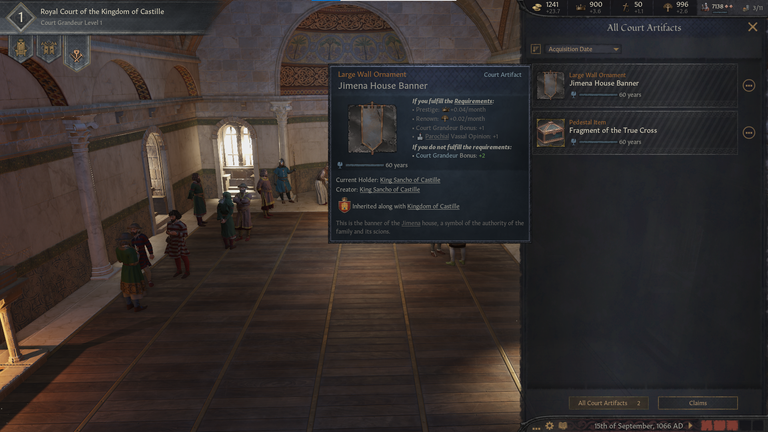
Every ruler with a royal court starts with a House Banner, regardless of whether or not they are their House Head. This can result in the existence of multiple House Banners for the same house, if there are multiple kings or emperors from the same house. For example, in 867 there will be multiple Karling House Banners and in 1066 there will be multiple Jimena House Banners.
The quality of the House Banner seems to be related to the Level of Splendor of that dynasty. In 1066, all House Banners will be Common or Masterwork.
6. FIXED HISTORIC ARTIFACTS
In 1066 there are 8 fixed inventory artifacts that are always allocated to specific historic characters:
| Character | Location | Artifact | Quality | Type | Requirements |
|---|---|---|---|---|---|
| Basileus Konstantinos X of the Byzantine Empire | Byzantine Empire | Monomachus Crown | Famed | Crown | |
| Kaiser Heinrich IV of the Holy Roman Empire | Holy Roman Empire | Reichskrone | Famed | Crown | |
| Pope Alexander II | Papacy | Papal Tiara | Illustrious | Crown | Papacy Only |
| Infanta Urraca Fernandez of Castille | County of Zamora | Chalice of Dona Urraca | Famed | Trinket | Christian |
| Caliph al-Mustansir ibn az-Zahir of the Fatimid Sultanate | Kingdom of Egypt | al-Taj al-Sharif | Illustrious | Crown | |
| Caliph al-Mustansir ibn az-Zahir of the Fatimid Sultanate | Kingdom of Egypt | Qadib al-Mulk | Illustrious | Regalia | |
| Caliph al-Qa'im ibn al-Qadir | Sunni Caliphate (Duchy of Baghdad) | Mantle of the Prophet | Illustrious | Regalia | Muslim |
| Emir Yahya ibn al-Zafir of Tulaytulah | Duchy of Tutaytulah | (Former) Bells of Santiago | Illustrious | Trinket | Muslim (Convertible for Christians) AND Involved or Interloper in Iberian Struggle |

The Chalice of Dona Urraca and (Former) Bells of Santiago require the Fate of Iberia DLC. The (Former) Bells of Santiago can only be used by Muslim characters but Christian owners have access to a decision to reforge them as the Bells of Santiago, which is only usable by Christian characters. In turn, a Muslim owner of the Bells of Santiago can reforge them back into the (Former) Bells of Santiago.
Please note that besides the religion requirement, only a character who is Involved or an Interloper in the Iberian Struggle can utilize the full benefits of the Bells (or Former Bells). This requirement is not clear from the tooltip. So if you are a Christian/Muslim ruler outside of Iberia and the tooltip shows that you do not meet the requirements (even though you are of the correct religion), it is because you do not fulfill the Involved/Interloper requirement.
In 1066 there are 23 fixed royal court artifacts that are always allocated to specific historic characters:
| Character | Location | Artifact | Quality | Type | Requirements |
|---|---|---|---|---|---|
| Basileus Konstantinos X of the Byzantine Empire | Byzantine Empire | Crown of Nikephoros II Phokas | Famed | Pedestal | |
| Basileus Konstantinos X of the Byzantine Empire | Byzantine Empire | Crown of Justinian | Illustrious | Pedestal | |
| Basileus Konstantinos X of the Byzantine Empire | Byzantine Empire | Image of Edessa | Illustrious | Pedestal | Christian |
| Basileus Konstantinos X of the Byzantine Empire | Byzantine Empire | Pentapyrgion | Masterwork | Furniture | |
| Kaiser Heinrich IV of the Holy Roman Empire | Holy Roman Empire | Iron Crown of Lombardy | Illustrious | Pedestal | |
| Kaiser Heinrich IV of the Holy Roman Empire | Holy Roman Empire | Kinderkrone | Famed | Pedestal | |
| Kaiser Heinrich IV of the Holy Roman Empire | Holy Roman Empire | Throne of Charlemagne | Illustrious | Throne | |
| King Philippe of France | Kingdom of France | Skull Cap of Charlemagne | Illustrious | Pedestal | |
| King Malcolm III 'Canmore' of Scotland | Kingdom of Scotland | Stone of Scone | Illustrious | Throne | |
| King Harold II Godwineson of England | Kingdom of England | Curtana | Illustrious | Pedestal | |
| King Harold II Godwineson of England | Kingdom of England | Head of St. Edmund | Illustrious | Pedestal | Christian |
| Duke Otto of Bavaria | Duchy of Bavaria | Sword of God | Illustrious | Pedestal | |
| Caliph al-Mustansir ibn az-Zahir of the Fatimid Sultanate | Kingdom of Egypt | al-Sayf al-Khass | Illustrious | Pedestal | |
| Caliph al-Mustansir ibn az-Zahir of the Fatimid Sultanate | Kingdom of Egypt | Banner of Thankfulness | Illustrious | Large Wall Ornament | Muslim |
| Caliph al-Mustansir ibn az-Zahir of the Fatimid Sultanate | Kingdom of Egypt | al-Dawat | Illustrious | Pedestal | |
| Caliph al-Mustansir ibn az-Zahir of the Fatimid Sultanate | Kingdom of Egypt | al-Hafir | Illustrious | Pedestal | |
| Caliph al-Qa'im ibn al-Qadir | Sunni Caliphate (Duchy of Baghdad) | Spear of the Prophet | Illustrious | Pedestal | Muslim |
| King Anawrahta of the Pagan Kingdom | Kingdom of Pagan | Piece of Kassapa's Robe | Illustrious | Pedestal | Buddhist |
| King Anawrahta of the Pagan Kingdom | Kingdom of Pagan | Staff of Kakusandha | Illustrious | Pedestal | Buddhist |
| King Anawrahta of the Pagan Kingdom | Kingdom of Pagan | Water Filter of Konagamana | Illustrious | Pedestal | Buddhist |
| King Anawrahta of the Pagan Kingdom | Kingdom of Pagan | Vinaya Pitaka | Famed | Book | |
| King Anawrahta of the Pagan Kingdom | Kingdom of Pagan | Sutta Pitaka | Famed | Book | |
| King Anawrahta of the Pagan Kingdom | Kingdom of Pagan | Abhidhamma Pitaka | Famed | Book |

Please note that Duke Otto of Bavaria and Caliph al-Qa'im ibn al-Qadir (Duchy of Baghdad) start with a royal court artifact even though they do not have royal courts.
The various Pitaka books are not unique. Additional copies can be found from Adventure Inspirations. So it is possible to have 2 different Vinaya Pitakas displayed in your royal court, giving you +2 max Sway schemes.
7. RANDOM RELIGIOUS ARTIFACTS
At the start of the game in 1066, around 24 random religious artifacts seem to be randomly generated and distributed. The breakdown seems to be: 6 Christian, 6 Muslim, 6 Buddhist, 2 Hindu, 2 Asatru, 1 Slavic, and 1 Senegambian.
There do not seem to be randomly generated artifacts for Judaism, Jainism, Zoroastrianism, Finno-Ugric, or Tengri even though such religious artifacts exist in the game and the 1066 start has 2 Kings that are Tengri (Cumania and Pechenegs).
And even though the 1066 start has a King that is Bidaic (Ghana), there doesn't seem to be any special artifacts for that religion right now.
A. 6 Random Christian Artifacts
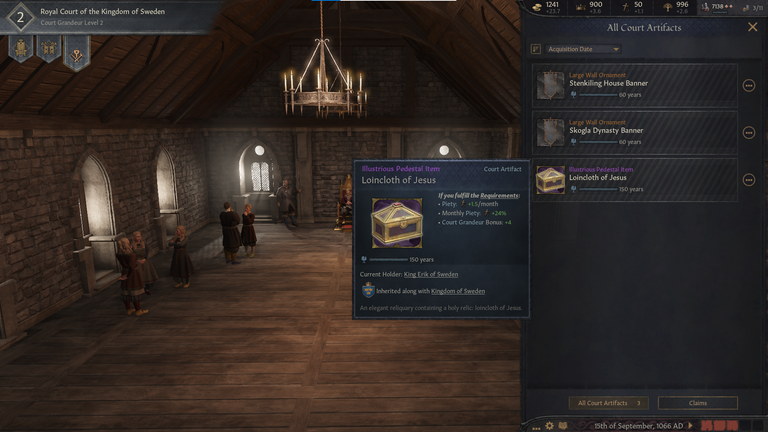
6 Christian artifacts are randomly generated and randomly distributed among the Christian rulers with a royal court (i.e. not to any Counts or Dukes and not to a theocracy). There seems to be a limit of one random Christian artifact per ruler, but it is possible for a ruler with a Fixed Historic Artifact (like Basileus Konstantinos X, Kaiser Heinrich IV, King Philippe, King Malcolm III, or King Harold II Godwineson) to also get a random religious artifact.
In the 1066 start there are 19 non-Theocratic Christian rulers with a royal court who are eligible to receive such a random Christian artifact: the Byzantine Empire, the Holy Roman Empire, and the Kingdoms of Abyssinia, Aragon, Castille, Croatia, Denmark, England, France, Galicia, Georgia, Hungary, Leon, Navarra, Norway, Poland, Ruthenia, Scotland, and Sweden. As a result, there is a 6/19 chance that any of these rulers will start with one.
In Version 1.11 Peacock, most of the 6 random Christian artifacts tend to be Illustrious (though I've also seen extreme cases where 1 is Illustrious and 5 are Common). Back during Version 1.6 Castle, the distribution tended to be 3 Illustrious + 3 Masterwork or 4 Illustrious + 2 Masterwork (and one time I did see 5 Illustrious + 1 Masterwork).
There can only be one Crown of Thorns, Girdle of Mary, Loincloth of Jesus, Sandals of Jesus, Spear of Destiny, and Veil of Veronica but there can be multiple Arms of St. George, Skulls of St. John the Evangelist, Fragments of the True Cross, Holy Nails, and Holy Thorns.
B. 6 Random Muslim Artifacts

6 Muslim artifacts are randomly generated and randomly distributed among the Muslim rulers with a royal court (i.e. not to any Counts or Dukes). There seems to be a limit of one random Muslim artifact per ruler, but it is possible for a ruler with a Fixed Historic Artifact (like Caliph al-Mustansir ibn az-Zahir) to also get a random religious artifact.
In the 1066 start there are 10 Muslim rulers with a royal court who are eligible to receive such a random Muslim artifact: the Seljuk (Persian) Empire, and the Kingdoms / Sultanates / Khanates / Grand Emirates of Africa, Alid (Transoxiana), Almoravid (Maghreb), Dulo (Volga Bulgaria), Fatimid (Egypt), Ghaznavid (Kabulistan), Khorasan, Soomra (Sindh), and Zhetysu. As a result, there is a 6/10 chance that any of these rulers will start with one.
In Version 1.11 Peacock, most of the 6 random Muslim artifacts tend to be Illustrious. Back during Version 1.6 Castle, the distribution tended to be 3 Illustrious + 3 Masterwork or 4 Illustrious + 2 Masterwork.
There can only be one Cloak of Muhammad, Hand of Yahya, Holy Banner of Muhammad, Keys to the Kaaba, and Seal of Muhammad but there can be multiple Swords of Muhammad, Hairs of Muhammad, and Teeth of Muhammad.
C. 6 Random Buddhist Artifacts
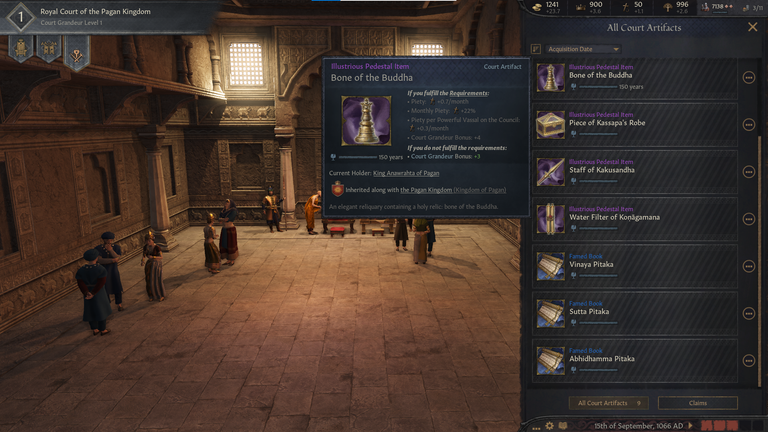
6 Buddhist artifacts are randomly generated and randomly distributed among the Buddhist rulers with a royal court (i.e. not to any Counts or Dukes). There seems to be a limit of one random Buddhist artifact per ruler, but it is possible for a ruler with a Fixed Historic Artifact (like King Anawrahta) to also get a random religious artifact.
In the 1066 start there are 7 Buddhist rulers with a royal court who are eligible to receive such a random Buddhist artifact: the Kingdoms of Great Liao, Guge, Maryul, Mjinjaa, Qocho, Pagan, and Pala. As a result, there is a 6/7 chance that any of these rulers will start with one.
In Version 1.11 Peacock, these 6 random Buddhist artifacts tend to be Illustrious. Back during Version 1.6 Castle, the Buddhist artifacts were occasionally Illustrious but often were Masterwork or Common.
There can only be one Alms-bowl of the Buddha, Robes of the Buddha, and Tongue of Kumarajiva but there can be multiple Bones of the Buddha, Branches of the Bo Tree, Hairs of the Buddha, Sariras, and Teeth of the Buddha.
D. 2 Random Hindu Artifacts
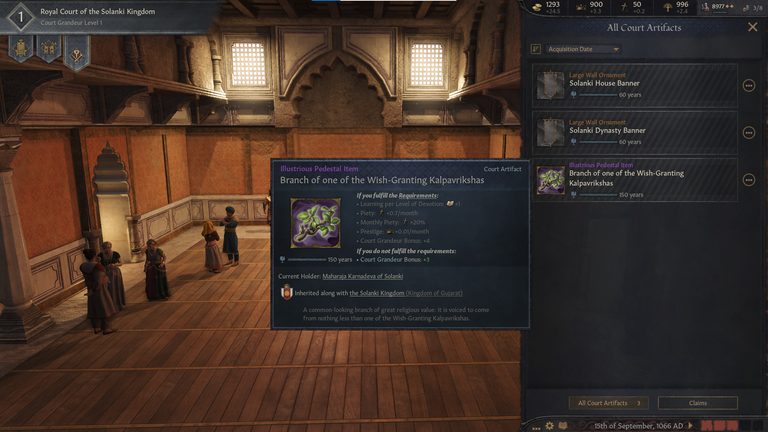
Exactly 2 Illustrious Branch of one of the Wish-Granting Kalpavrikshas are randomly generated and randomly distributed among Hindu rulers with a royal court (i.e. not to any Counts or Dukes). There seems to be a limit of one random Hindu artifact per ruler.
In the 1066 start there are 9 Hindu rulers with a royal court who are eligible to receive such a random Hindu artifact: the Kingdoms of Bhauma Pala (Kamarupa), Cedi (Gondwana), Chauhan (Rajputana), Chola (Tamilakam), Kalyani Chalukya (Karnata), Lohara (Kashmir), Paramara (Malwa), Solanki (Gujarat), and Somavamsi (Orissa). As a result, there is a 2/9 chance that any of these rulers will start with one.
E. 2 Random Asatru Artifacts
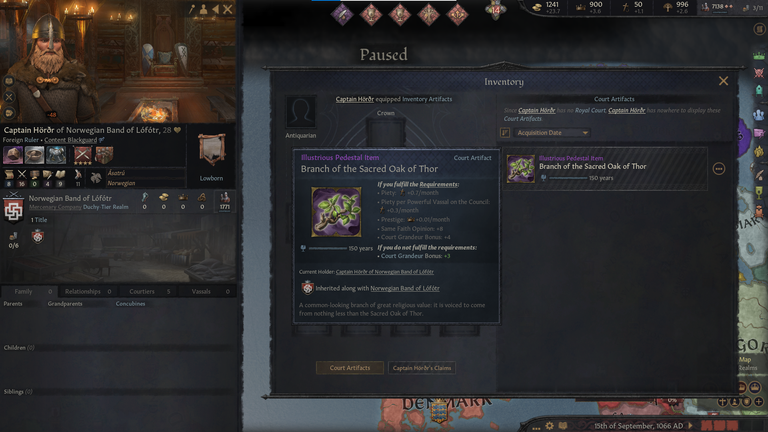
Exactly 2 Illustrious artifacts are randomly generated and randomly distributed among Asatru rulers or mercenary leaders, regardless of whether or not they have a royal court (since neither 867 or 1066 have any Asatru Kings or Emperors). There seems to be a limit of one random Asatru artifact per ruler.
In the 1066 start, there is 1 duke, 3 mercenary bands, and 7 counts who are eligible candidates. As a result, there is a 2/11 chance that any given Asatru ruler starts with one. In the 1066 start there are fewer Asatru rulers so there is a higher chance that an Asatru mercenary leader starts with one of these Branches.
The 2 artifacts can be either Branch of the Sacred Oak of Thor or Branch of the Sacred Tree at the Temple of Uppland. It is possible that one of each is generated or it is possible that both artifacts are the same name/type.
Unlike the Christian, Muslim, Buddhist, and Hindu religious artifacts which can only be given to a ruler with a royal court, the Asatru, Slavic, and Senegambian religious artifacts can be given to a ruler without a royal court since there are no starting characters who are King or Emperor level. It is also possible for an Asatru, Slavic, or Senegambian mercenary leader to start with a religious artifact.
F. 1 Random Slavic Artifact
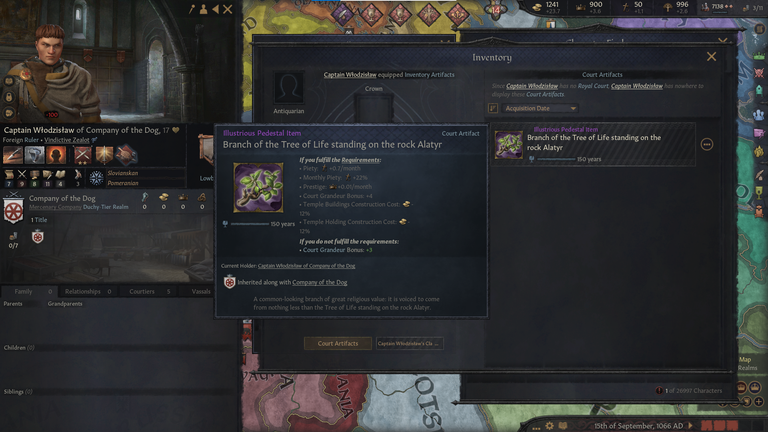
Exactly one Illustrious Branch of the Tree of Life standing on the rock Alatyr is randomly generated and randomly given to a Slavic ruler or mercenary leader, regardless of whether or not they have a royal court (since neither 867 or 1066 have any Slavic Kings or Emperors).
In the 1066 start, there are 3 dukes, 4 mercenary bands, and 3 counts who are eligible candidates. As a result, there is a 1/10 chance that any given Slavic ruler starts with the Illustrious Branch. In the 1066 start there are fewer Slavic rulers so there is a higher chance that a Slavic mercenary leader starts with this Branch.
G. 1 Random Senegambian Artifact
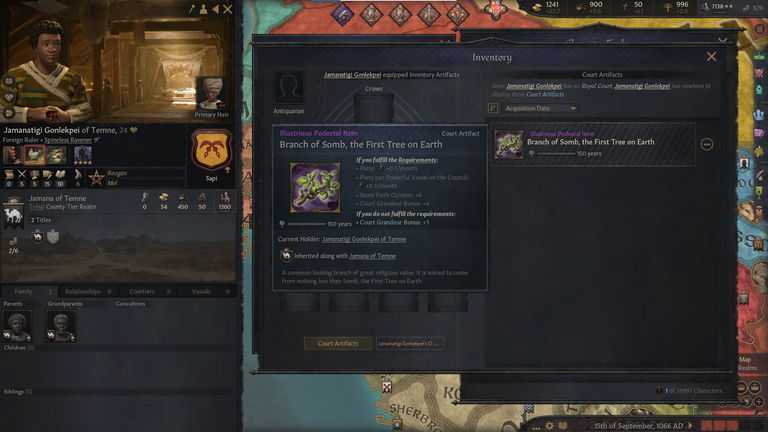
Exactly one Illustrious Branch of Somb, the First Tree on Earth is randomly generated and randomly given to a Senegambian ruler or mercenary leader, regardless of whether or not they have a royal court (since neither 867 or 1066 have any Senegambian Kings or Emperors).
In the 1066 start, there are 1 duke, 3 mercenary bands, and 10 counts who are eligible candidates. As a result, there is a 1/14 chance that any given Senegambian ruler starts with the Illustrious Branch. In the 1066 start there are fewer Senegambian rulers so there is a higher chance that a Senegambian mercenary leader starts with this Branch.
8. RANDOM NON-UNIQUE ARTIFACTS
A. 5 Visigothic Votive Crowns
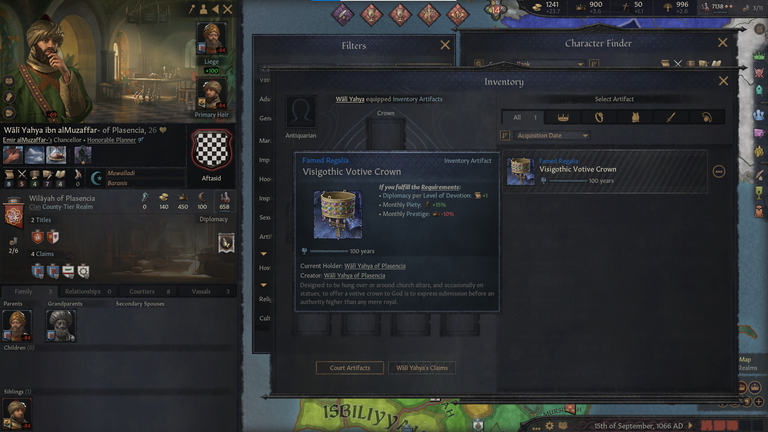
If you have the Fate of Iberia DLC, then 5 random Christian or Muslim rulers in Iberia (of Count rank or higher) will start with a Famed quality Visigothic Votive Crown (which is regalia and not a crown, despite its name). These all have identical stats and are only usable by Christians (even though some Muslims may start with one). Since this is an inventory item, it is possible for rulers without a royal court to start with one. There does seem to be a limit of one starting Visigothic Votive Crown per ruler.
B. 6 Excaliburs
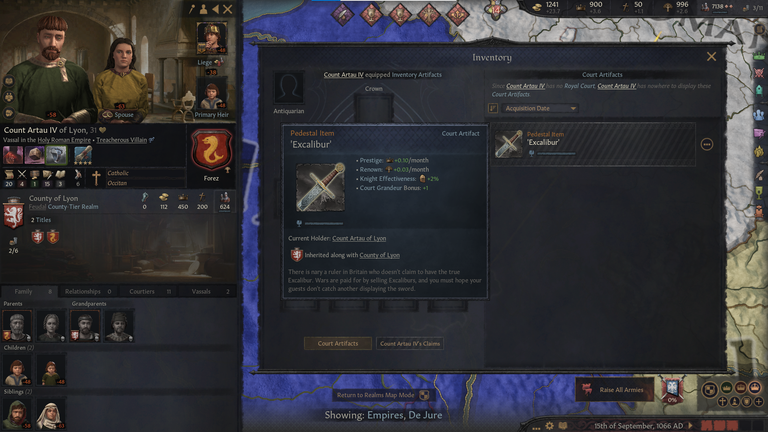
The game also seems to randomly generate 6 Common Excaliburs (all with identical stats). Even though this is a royal court (pedestal) artifact, these seem to be randomly distributed among 6 different rulers WITHOUT a royal court (i.e. Counts or Dukes) in Britannia or Francia. There does seem to be a limit of one starting Excalibur per ruler.
9. EASTER EGG CHARACTERS
In 1066, there are 6 unlanded characters who start with artifacts. Presumably, these represent Paradox Interactive employees rather than historic characters.
| Character | Location | Artifact | Quality | Type | Requirements |
|---|---|---|---|---|---|
| Elisabeth 'the Silly' Andriamasinavalona | Unlanded in Rogaland | Elisabeth's Stuffed Fox | Common | Trinket | |
| Ewan 'the Trustworthy' Cowhig Croft | Unlanded in Herefordshire | Alexander's Skull | Common | Trinket | |
| Ewan 'the Trustworthy' Cowhig Croft | Unlanded in Herefordshire | Daniel's Skull | Common | Trinket | |
| Ewan 'the Trustworthy' Cowhig Croft | Unlanded in Herefordshire | Joseph's Skull | Common | Trinket | |
| Ewan 'the Trustworthy' Cowhig Croft | Unlanded in Herefordshire | Nicholas' Skull | Common | Trinket | |
| Ewan 'the Trustworthy' Cowhig Croft | Unlanded in Herefordshire | Tegan's Skull | Common | Trinket | |
| Chad | Unlanded in Regensburg | The Annotated Aeneid | Common | Trinket | |
| Chad | Unlanded in Regensburg | The Dagger | Common | Weapon | |
| Veronica Pazps | Unlanded in Santiago | The Rings of the Lord | Famed | Trinket | |
| Nicholas 'the Girthy' Meredith | Unlanded in Suthweorc | Happy Gaoler | Common | Weapon | |
| Giasone Cantalini | Unlanded in Fermo | Sword of St. Martin | Common | Weapon |
It may be interesting to note that in Version 1.6 Castle, Elisabeth 'the Silly' Andriamasinavalona and Ewan 'the Trustworthy' Cowhig Croft were present but the other 4 characters were not present with their unique artifacts. Back in 1.6 Castle, artifacts of any type (especially trinkets) were much rarer but ever since the Tours and Tournaments DLC, it is a lot easier to fill your artifact slots.
None of these Easter Egg artifacts are so powerful that you need to track them down unless you want to do it for fun. You can usually find equivalent or better artifacts. All of these artifacts are Common, except for Veronica's The Rings of the Lord which is Famed.
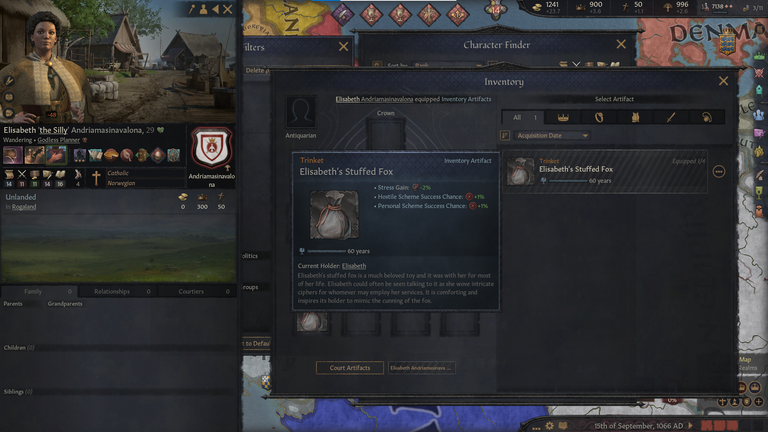
- Elisabeth's Stuffed Fox is cute (as I'm sure Finnegan Fox would agree) but the artifact stats are typical for a Common artifact.
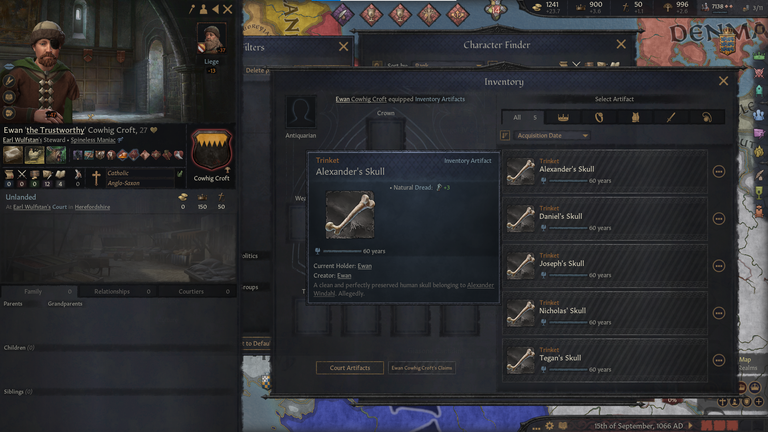
- The most noteworthy thing about Ewan's skulls is that they are inventory trinkets whereas most skulls that you obtain in the game are pedestal items. I suppose you could quickly boost your Dread if you have enough of these items.
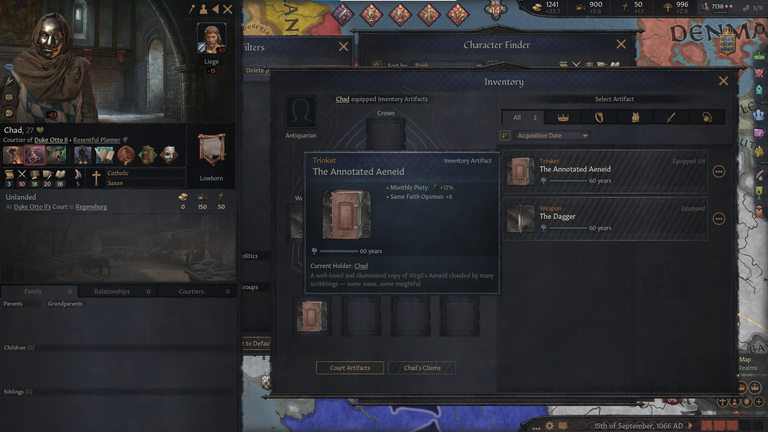
- Chad's Annotated Aeneid has +12% monthly piety (more typical of a Masterwork artifact) and +8 Same Faith Opinion (which is more characteristic of an Illustrious artifact than a Common one).
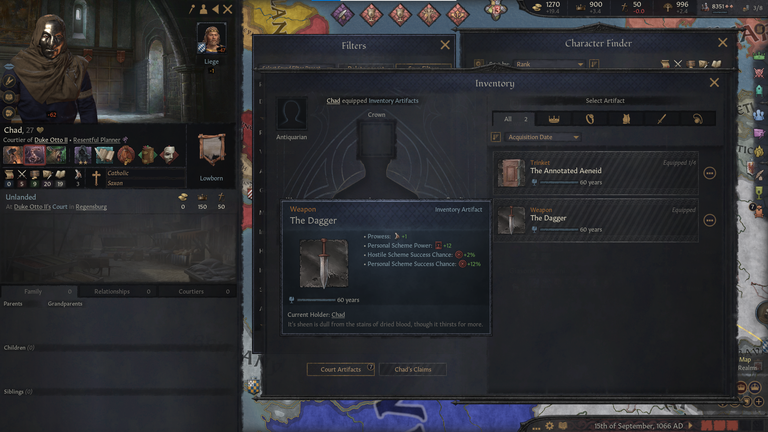
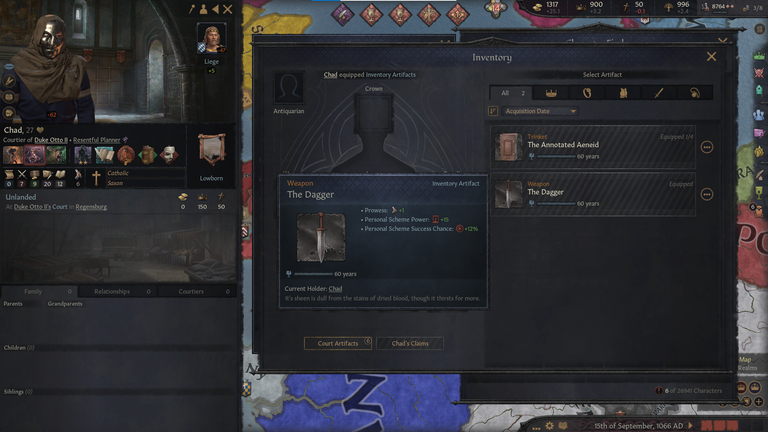
- Chad's The Dagger is probably the best of the Easter Egg artifacts. This one seems to have some random elements and the exact abilities may vary from game to game (whereas the other Easter Egg artifacts seem to have mostly fixed abilities). The Dagger seems to have Personal Scheme Power of 12+ and Personal Scheme Success +12% or higher, which is what Illustrious daggers tend to have. Sometimes, the Dagger might even have a rating that is +15, which is higher than what you would normally find in other artifacts. Nonetheless, the Prowess bonus is low (typical of a Common weapon), so you might still prefer a genuine Illustrious dagger.
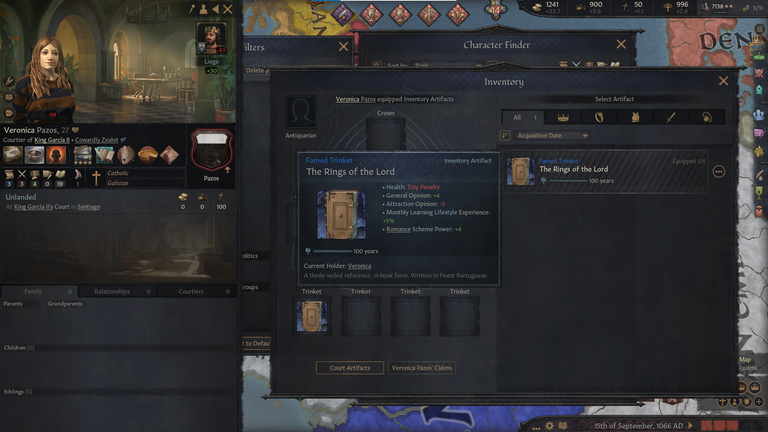
- Veronica's The Rings of the Lord is of Famed quality. The +4 General Opinion is usually only found on Illustrious artifacts but it does come with two minor penalties.
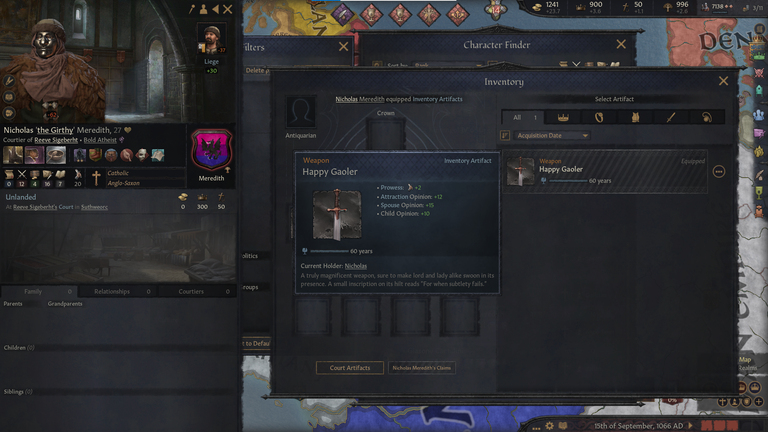
- Nicholas' Happy Gaoler has +12 Attraction Opinion (which is Famed level), +15 Spouse Opinion (also Famed level), and +10 Child Opinion (which normally doesn't appear on most artifacts). Nonetheless, Spouse Opinion and Child Opinion are rather cornercase in use.
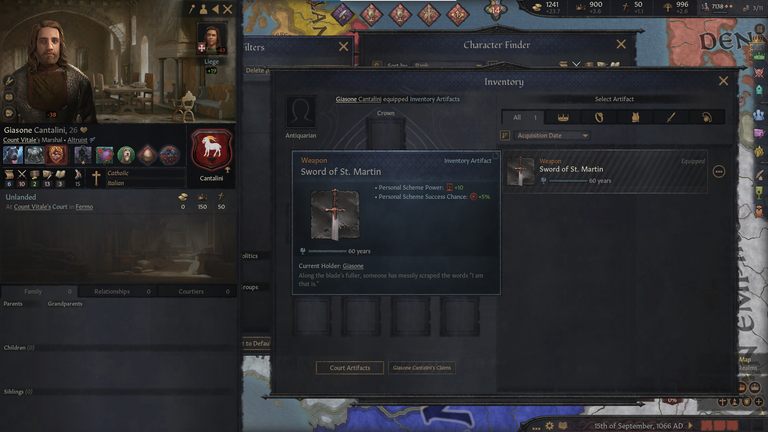
- Giasone's Sword of St. Martin has +10 Personal Scheme Power (which is Illustrious level) and +5% Personal Scheme Chance (which is Masterwork level).
10. ANALYSIS
If you enjoy artifact hunting and want a good start then beyond any dynasty/house banners, the Byzantine Empire starts with 1 inventory artifact and 4 royal court artifacts, the Holy Roman Empire starts with 1 inventory artifact and 3 royal court artifacts, the Fatimid Sultanate (Egypt) starts with 2 inventory artifacts and 4 royal court artifacts, and the Kingdom of Pala starts with 6 royal court artifacts. The Sunni Caliph (Duchy of Baghdad) starts with 1 inventory artifact and 1 royal court artifact but has no royal court. England starts with 2 royal court artifacts while France and Scotland each start with 1 royal court artifact. Duke Otto of Bavaria also has a royal court artifact but does not have a royal court. Infanta Urraca of Zamora and Emir Yahya of Tutaytulah each start with 1 inventory artifact. The Papacy is not playable because it is a theocracy.
Furthermore, if you really want to optimize things you can keep restarting the game until your chosen ruler starts with a random religious artifact (preferably an Illustrious one). The 7 Buddhist Kings have a 6/7 chance to get a random religious artifact, the 10 Muslim Kings/Emperor have a 3/5 chance, the 19 Christian Kings/Emperors have a 6/19 chance, and the 9 Hindu Kings have a 2/9 chance.
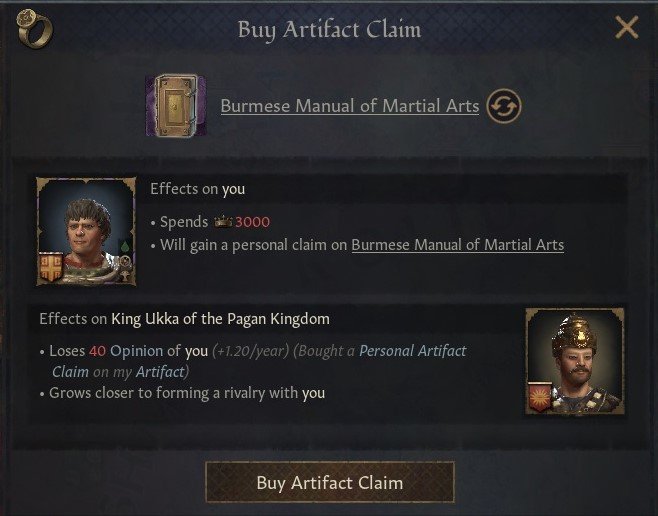
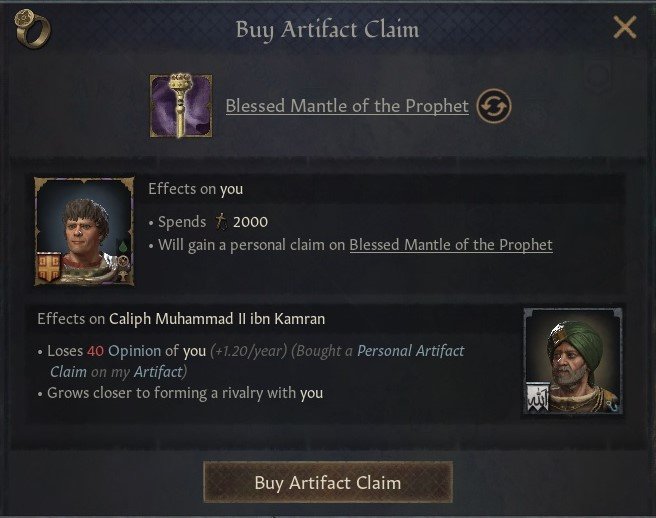
If you want to collect artifacts in your game, then the most reliable method is to pursue the Diplomat perk tree for the Accomplished Forger perk. Once you have that perk, you can spend prestige or faith to get a claim on an artifact and once you have a claim, you can demand it, declare a war for it, duel for it, or steal it with a hostile scheme. Demanding or dueling for an artifact has a multi-year cooldown. Stealing an artifact has a cooldown against that same target but no cooldown against different rulers. It is possible to loot artifacts by sieging a character's capital holding but you have an extremely low chance of looting an Illustrious artifact. One other option is if you usurp a kingdom/empire title so that the artifact holder no longer has a royal court, then you will immediately "inherit" their royal court artifacts.
Also, if you want to appropriate these artifacts, your realm will need sufficient diplomatic range. The Byzantine Empire, Holy Roman Empire, France, and Egypt are fairly central from the Mediterranean. It may take some effort to reach England and Scotland in the northwest corner while Pagan is all the way on the eastern end of the map. Controlling the Rock of Gibraltar can help expand your diplomatic range and you may want to leapfrog across sea zones.
However, you can skip artifacts that you don't meet the requirements for. You can always skip the Papal Tiara unless you want the bragging rights. Non-Muslims can ignore the artifacts held by the Sunni Caliph in Baghdad. And if you don't plan to be involved in the Iberian Struggle or you are not Christian or Muslim, you can bypass the (Former) Bells of Santiago.
It can be hard to get a good throne since you can't specifically commission one, which makes the Stone of Scone or Throne of Charlemagne tempting. Both Curtana and the Skull Cap of Charlemagne make your knights more effective, while the latter also decreases the maintenance for your men-at-arms. The Crown of Justinian, Reichskrone, and Iron Crown of Lombardy all increase your vassal limits, while the Crown of Justinian also increases your domain limit. And the Pitaka books provide lots of renown and piety, as well as other benefits. Thus, Scotland, England, France, the Holy Roman Empire, the Byzantine Empire, and Pagan are the juiciest targets for powerful artifacts that can be used by any character.
Updated April 6th, 2024:
Added a link to the 867 vs 1066 comparison article
Added screenshots of two of the random events in the Persia region that can give you random artifacts
Confirmed that Achaemenid Drinking Vessels come in all 4 quality levels
Made a slight wording correction since I discovered Tengri artifacts do in fact exist in the game (though there are none in the 1066 start)
Added screenshots of using Accomplished Forger to buy artifact claims